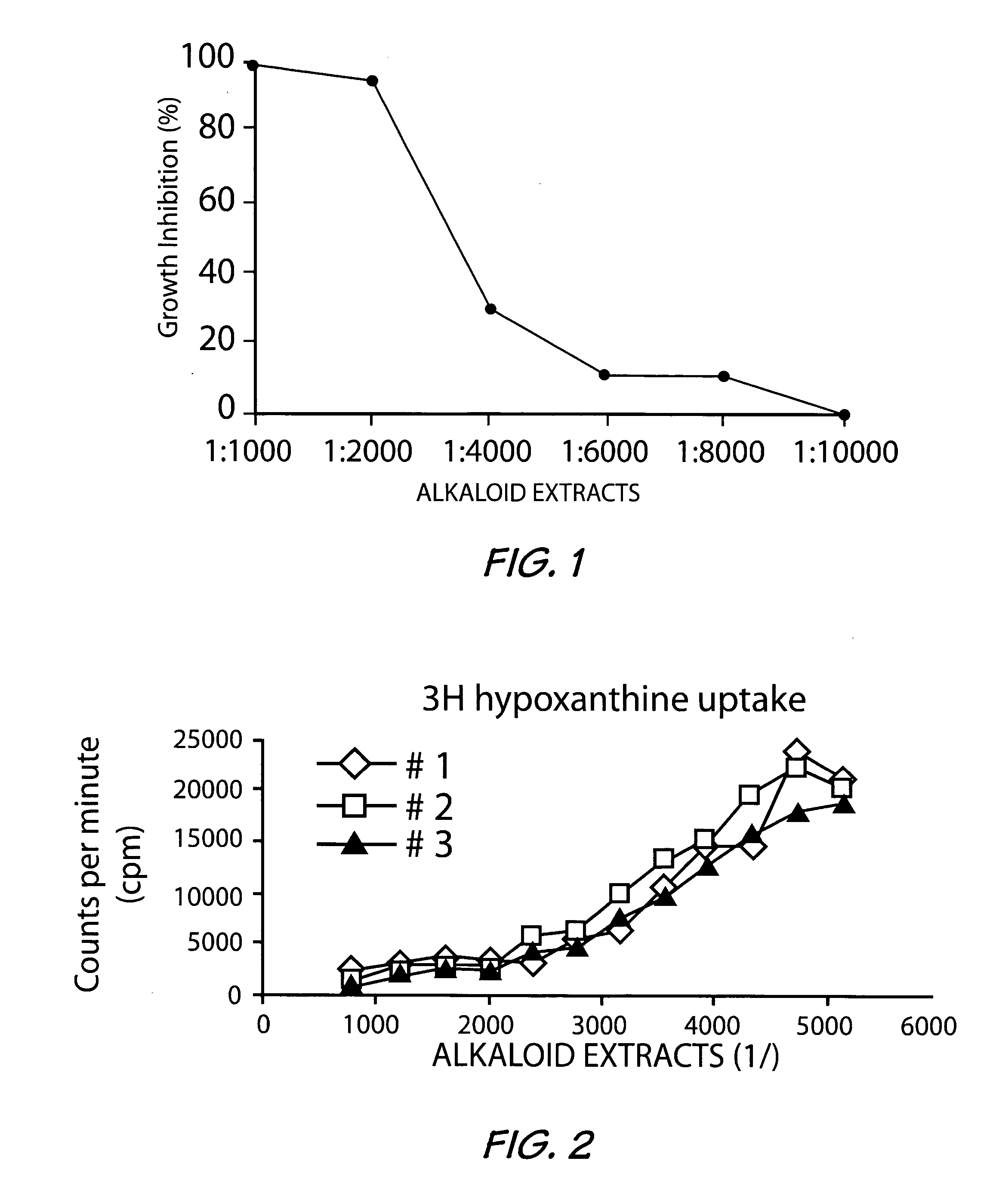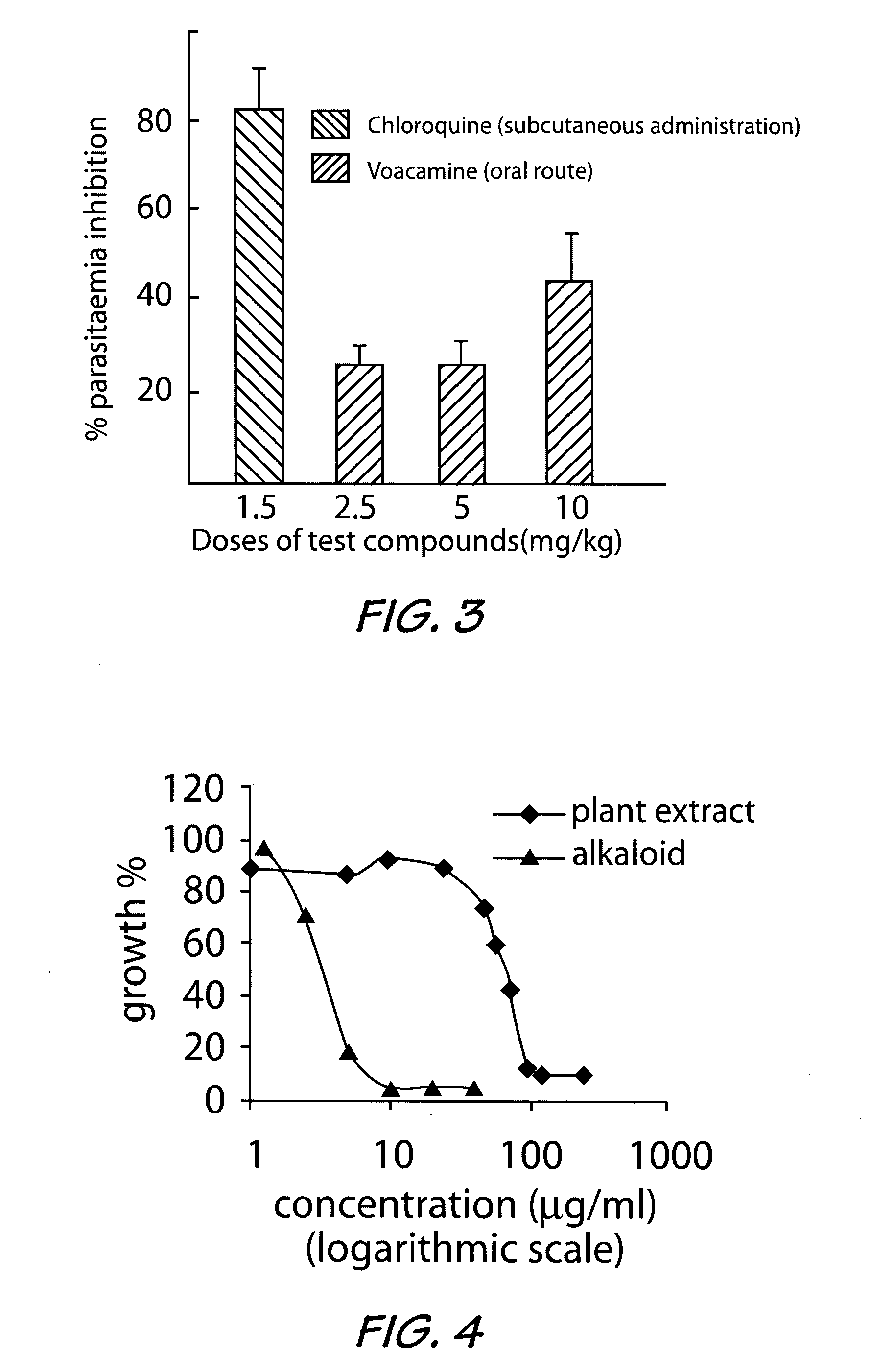Anti-parasitic and/or anti-viral and/or anti-microbial compositions
a technology of compositions and antivirals, applied in the field of antiviral and/or antiviral compositions, can solve the problems of aminocrinodines, which are unfortunately toxic, and threaten the life of nearly one-fourth of the human population
- Summary
- Abstract
- Description
- Claims
- Application Information
AI Technical Summary
Benefits of technology
Problems solved by technology
Method used
Image
Examples
example 2
Purification
[0022] The diverse tertiary alkaloids contained in the basic extract of Example 1, were separated by countercurrent distribution, with dichloromethane as the stationary phase and an aqueous buffer with an incrementally decreasing pH (mobile phase). The alkaloids were recovered from the aqueous phase by extraction with dichloromethane.
[0023] The equipment used was a Craig type Post apparatus made up of 200 glass tubes (with 10 ml volumes for the lower phase and 10 ml volumes for the upper phase).
[0024] At pH 7, a first series of minor alkaloids were obtained, then at pH 5.2, there were eluted in order, perivine (KrKb=4×10−9) 16-epi-affinine (KrKb=2.5×10−9) and affinisine (KrKb=7×10−10); where Kr is the partition coefficient (aqueous phase / organic phase repartition) and Kb is the dissociation constant.
[0025] At pH 4, N-demethylvoacamine (KrKb=3.5×10−11) and vobasine (KrKb=4×10−11) were eluted.
[0026] At pH 3.2, voachalotine (KrKb=2×10−11) and voacamine (KrKb=1.3×10−11)...
example 3
Extract Analysis
[0032] The alkaloids in the basic extract were quantified using the following analytical method, which was validated. Calibration curves were constructed by dissolving purified alkaloids in a known amount of dichloromethane. A precise volume of the solution was taken, evaporated and diluted in a mixture containing 0.1% trifluoroacetic acid (TFA), 18% acetonitrile and 72% water. The samples were done in triplicate and analyzed by high performance liquid chromatography / mass spectrum (HPLC / MS) and the response factor determined using ions characteristic for each compound. These ions were 353 (M+2H)+2, and 705 (M+H)+ for voacamine, 353 (M+H)+ for vobasine and 367 (M+H)+ for voachalotine. A calibration curve was performed for each of these ions at each concentration.
[0033] The residue crystallized from 300 mg of extract was dissolved in a mixture containing 0.1% TFA, 18% acetonitrile and 72% water. The mixture was sonicated 5 minutes, passed on a 0.2 μm polytetrafluoroe...
example 4
In Vitro Antiplasmodial Activity
[0035] The basic extracts obtained as in Example 1, from both the root and stem bark with a yield of 1.9% were used to carry out the in vitro antiplasmodial activity study on known Plasmodium falciparum strains. The results obtained are reported in Tables 3 and 4 below.
[0036]Plasmodium falciparum strains D6 and W2 were used throughout this investigation. Laboratory isolates of P. falciparum were grown under controlled conditions in culture medium containing leukocyte-free red blood cells (RBCs) at 5% hematocrit (Tager and Jensen, 1976). Briefly, parasites were allowed to infect RBCs in a media consisting of RPMI 1640 plus 25 mM Hepes, 0.25 glucose, 0.2% sodium bicarbonate, 0.5% Albumax II, and 50 mg / liter hypoxanthine and grown in 5% CO2 at 37° C. When required, cultures were synchronized by sorbitol treatment (D. Ramanitrahasimbola et al, 1999, Biological Activities of the Plant-derived Bisindole Voacamine with reference to Malaria. Phytother. Res....
PUM
| Property | Measurement | Unit |
|---|---|---|
| pH | aaaaa | aaaaa |
| volumes | aaaaa | aaaaa |
| retention time | aaaaa | aaaaa |
Abstract
Description
Claims
Application Information
 Login to View More
Login to View More - R&D
- Intellectual Property
- Life Sciences
- Materials
- Tech Scout
- Unparalleled Data Quality
- Higher Quality Content
- 60% Fewer Hallucinations
Browse by: Latest US Patents, China's latest patents, Technical Efficacy Thesaurus, Application Domain, Technology Topic, Popular Technical Reports.
© 2025 PatSnap. All rights reserved.Legal|Privacy policy|Modern Slavery Act Transparency Statement|Sitemap|About US| Contact US: help@patsnap.com



